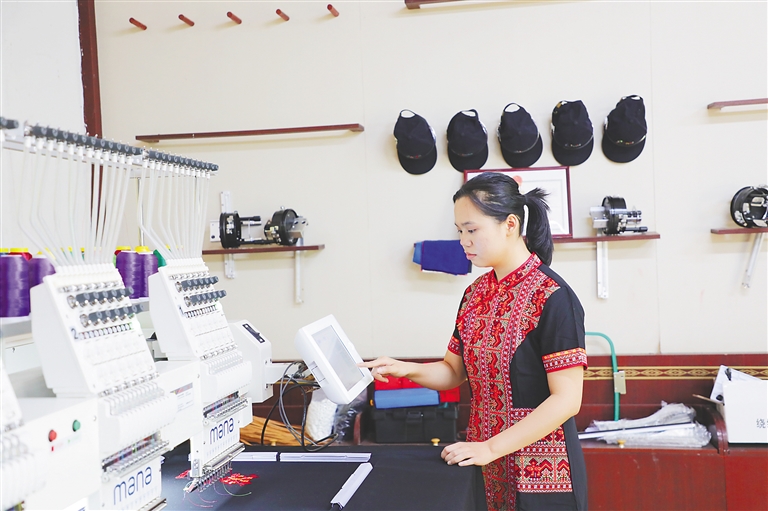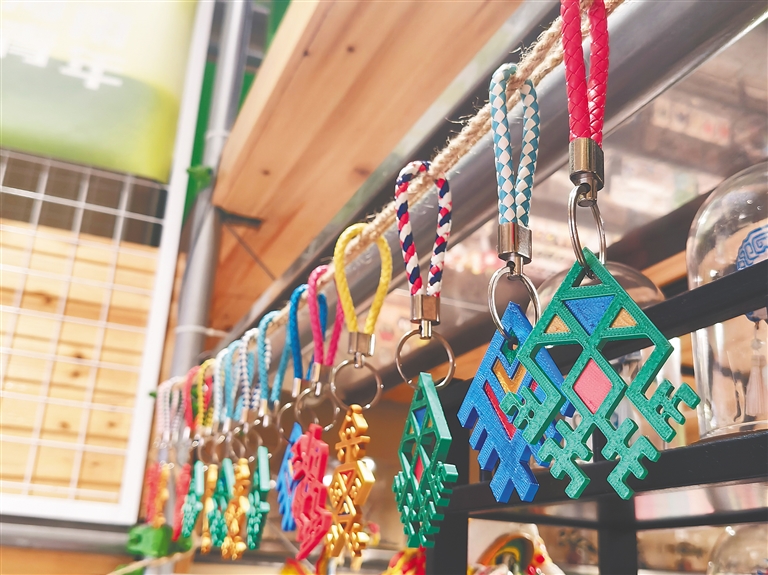Technology transforms intangible cultural heritages in S China's Hainan
From:People's Daily OnlineAuthor: 2025-06-19 14:39
In the past, discussions about intangible cultural heritage invariably centered around words like "endangered" and "highly difficult." However, a new wave driven by technology and creativity is gradually breaking down these stereotypes.
With a simple click of the mouse, designers can now produce Li brocade patterns that blend classic elegance with contemporary fashion. Meanwhile, 3D printing technology has opened up new possibilities for cultural and creative products derived from intangible cultural heritages.

Fu Beisi, head of a double-sided embroidery clothing cooperative in Nankai village, Nankai township, Baisha Li Autonomous County, south China's Hainan Province, operates an automated embroidery machine. (Photo/Yang Shunling)
New technologies, processes, and ideas are not only bringing intangible cultural heritages to life but also making them trendy and accessible to younger generations.
A double-sided embroidery clothing cooperative in Nankai village, Nankai township, Baisha Li Autonomous County, south China's Hainan Province introduced an automated embroidery machine in late February. Upon its debut, the cooperative soon landed a big order: producing over 1,100 pieces of Li brocade clothing and accessories for participants in the Sanyuesan Festival, a traditional festival celebrated by various ethnic groups in China on the third day of the third lunar month, all to be delivered within just over a month.
"The task was unimaginable in the past," said Fu Beisi, head of the cooperative. Previously, local embroiderers would need half a year to complete a single Li brocade garment. Now, with the help of the automated embroidery machine alongside other machines, the cooperative can produce 300 to 400 ready-to-wear garments in just 20 days.

Photo shows a Li brocade product. (Photo courtesy of the interviewee)
The embroidery machine can import patterns designed through software and replicate, splice, and combine various motifs, Fu said. The machine features eight embroidery heads that can simultaneously do embroidery work on eight pieces of fabric. It also handles double-sided stitching, silk threads, and needle work with remarkable precision.
With machines handling the bulk of the work, embroiderers now focus their expertise on fine-tuning Li ethnic garments and developing new patterns and clothing designs to ensure quality. While orders for machine-made Li brocade garments continue to surge, demand for purely handcrafted pieces has actually increased.
"I received an order for two handmade Li brocade garments and earned 7,000 yuan ($974.71) to 8,000 yuan," said Chen Chunying, a 50-year-old embroiderer in Nankai village.
Furthermore, young embroiderers in the village are unleashing their creativity by designing trendy bags and hairpins inspired by traditional Chinese culture, and dolls infused with ethnic elements. These products, with their adorable appearance and cultural connotations, have gained great popularity.
Li brocade geometric artworks created using 3D printing technology, including exquisite keychains, colorful fridge magnets, and creatively designed earrings, are on display at the YiYo Hainan Intangible Cultural Heritage Art Museum on Qilou Old Street in Haikou, capital of Hainan.

Photo shows a Li brocade product produced using AI technology. (Photo courtesy of the interviewee)
"As the younger generation, we have a responsibility to explore the charm of intangible cultural heritages and enhance our creative and promotional capabilities in ways that appeal to young people, making intangible cultural heritages more accessible in daily life," said Huang Yaosen, curator of the museum.
Huang conceived the idea of "combining 3D printing technology with cultural and creative products themed on intangible cultural heritages. He hoped to leverage 3D printing technology to offer customized services, allowing young people to engage with intangible cultural heritages in more fashionable and convenient ways.
Beyond "3D printing plus Li brocade," Huang plans to venture into new fields such as lacquerware, Chinese cloisonné, and ceramics, allowing technology and intangible cultural heritages to create even more innovative applications.

Photo shows keychains with Li brocade patterns made with a 3D printer. (Photo courtesy of the interviewee)
Recently, a salon themed "AI empowering Li brocade" was held at the Hainan Lingshui Li'an International Education Innovation Pilot Zone.
"We believe we can explore using AI technology for the regenerative design of Li brocade patterns," said Li Xin, a graduate student from the fine arts college of Hainan Normal University, at the event.
This involves using AI to decode the patterns, colors, and textures of Li brocade, enabling machines to learn their characteristics and generate images with similar styles or identical pattern structures, Li added.
This approach significantly shortens pattern design cycles and enables high-precision digital archiving of patterns while generating new designs through algorithms.
Edit:董麗娜
The copyright of the article and the picture belongs to the original author. If there is any infringement, please contact to delete it